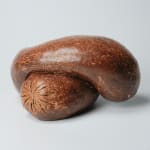Kumakura Junkichi 熊倉順吉 1920-1985
H12.4" x W21.3" x D21.0 cm
Further images
-
(View a larger image of thumbnail 1
)

-
(View a larger image of thumbnail 2
)

-
(View a larger image of thumbnail 3
)

-
(View a larger image of thumbnail 4
)

-
(View a larger image of thumbnail 5
)

-
(View a larger image of thumbnail 6
)

-
(View a larger image of thumbnail 7
)

-
(View a larger image of thumbnail 8
)

-
(View a larger image of thumbnail 9
)

-
(View a larger image of thumbnail 10
)

-
(View a larger image of thumbnail 11
)

-
(View a larger image of thumbnail 12
)

-
(View a larger image of thumbnail 13
)

-
(View a larger image of thumbnail 14
)

-
(View a larger image of thumbnail 15
)

-
(View a larger image of thumbnail 16
)

-
(View a larger image of thumbnail 17
)

-
(View a larger image of thumbnail 18
)

The iconic Irabo glaze has been used in the creation of daily vessels since the Korean Goryeo dynasty. Unearthed from sites in Busan and Yangsan, this ash glaze is renowned for its distinctive ash effects. Modern Japanese potters have long admired and sought to replicate this technique. The ash glaze, applied to functional objects, gracefully descends down the vessel's walls. Kumakura Junkichi harnesses the inherent qualities of ash, leveraging its weight and gravity to create an object that engages with these forces.
While it may initially appear as a sculpture, the piece gradually reveals its purpose as a flower vase. Thoughtfully designed, it features openings within its folds to accommodate flower stems. The organic, biomorphic forms of the vase offer a touch of the grotesque. In this artwork, Junkichi skillfully navigates the delicate balance between form and function, leading the viewer playfully in one direction while ultimately presenting the true nature of the object in a different light.

















